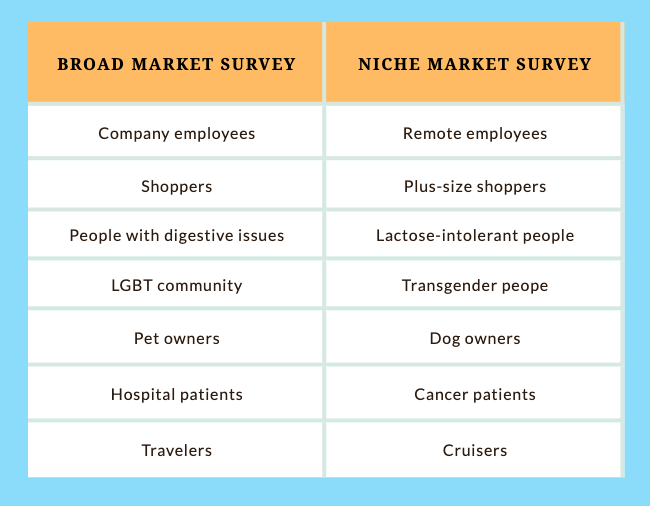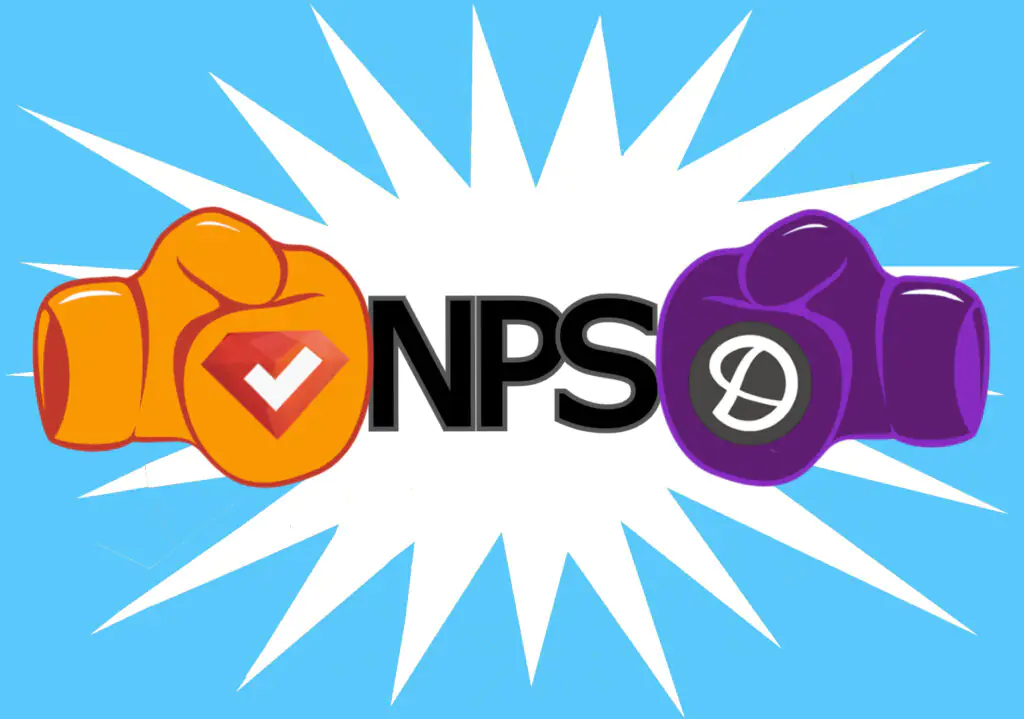Some surveys are broad in scope, aiming to collect feedback from the most people regardless of their background. Niche audience surveys are a bit more complicated. These types of surveys look for subgroups of larger audiences that may often be overlooked or underrepresented. Individuals in a niche audience may have unique hobbies, passions, beliefs, or requirements that set them apart. So how do you reach them? In this blog, we’ll look at how to target a niche audience and the benefits of doing so.
Create your FREE niche market survey now!
Niche Definition
Niche is defined as a specialized segment of the market for a particular kind of product or service. It can also denote products, services, or interests that appeal to a small, specialized section of the population. We often talk about people trying to find their niche in life, as in where they belong, how they fit in, what kind of work is right for them, and so on. A niche audience are those people that have already found their niche, and a researcher simply wants to know more about them.
Wondering how to pronounce “niche”? You’ve likely heard it said one of two ways. According to Webster’s, both variations are acceptable, meaning it can be pronounced like “neesh” or “nitch.”
What’s a Niche Market?
The niche market definition is a segment of a larger market that can be defined by its own unique needs, preferences, or identity that makes it different from the market at large. Just about any market can be whittled down into smaller niche groups based on some of the following attributes:
- Demographics (gender, age, income level, education level)
- Level of quality (premium, handmade, economical)
- Psychographics (values, interests, attitudes)
- Geographic (residents of a certain country, city, or even neighborhood)
- Price (luxury, moderate, discount)
Niche Market Examples
Here’s a look at seven broad audience categories compared to a more niche market.

Of course, while you would likely capture responses from members of niche groups within a broader survey, drilling down to their specifics provides you with much more accurate data to draw conclusions from.
10 Considerations for Niche Market Surveys
To effectively reach a niche audience with surveys, it’s important to consider the following ten points.
1. Target Your Survey Distribution
To reach a niche audience, first identify the channels, platforms, or communities where they congregate. For example, if you’re targeting avid birdwatchers, you might want to distribute your survey through specialized birdwatching forums, social media groups, or relevant websites.
2. Tailor Your Survey Design & Survey Images
It’s important to craft survey questions that resonate with the unique interests and needs of your niche audience. Use terminology, references, or specific language that they are familiar with to ensure relevance and engagement. You might also consider including survey images that will quickly convey the topic of the survey and catch the eye of the niche audience.
3. Ask the Right Questions
Even within a niche market, there may be some participants whose answers do little to help you learn more about them. To ensure your data is as relevant as possible, always ask the following types of questions on niche surveys.
- Screener Questions. Also known as qualifying questions, the responses to these help you identify which surveys to keep and which to discard. For example, if you’re a streaming service, you might ask respondents how they watch movies. If they prefer DVDs or physical media, you can opt to not include them in your results.
- Behavioral questions. Not all individuals in a niche market behave the same way, and you may want to only collect answers from some that behave in a specific manner. Depending on the purpose of the survey, behavioral screener questions may vary. Examples might be “How many hours per week do you volunteer?” or “Do you regularly vote in presidential elections?” Behavioral questions can also help researchers learn how niche audiences feel about a product. Questions might include, “What do you value in a product?” or “What compels you to make a purchase?”
- Demographic questions. These types of questions help you narrow your results down based on factors such as gender, age, race, education, income, employment status, and so on.
We have entire blogs on both demographic questions and survey screening questions. Check them out!
4. Use Thoughtful Incentives
It’s common to offer incentives, but often they are fairly generic (e.g., a Starbucks gift card). To engage with a niche audience, consider an incentive that will motivate them to participate. For example, if you’re targeting boat owners, consider a gift card or discount at West Marine. Or, say you’re surveying cancer survivors; you may say that with each completed survey, you donate $5 to the American Cancer Society.
5. Use Snowball Sampling
Sometimes, targeting specific groups that are hard to find or reach, or who may be hesitant to speak with them, become necessary. This is often the case when the topic is sensitive or personal, such as studies about illegal immigrants, drug users, or those with rare health conditions. In these cases, use snowball sampling.
This form of non-probability sampling involves finding a small pool of participants and then having them “nominate,” through their social circle, others they know who fit the criteria. Because the others are being recruited by someone they know, as opposed to the survey researcher, they’re more likely to participate, growing your number of respondents.
6. Use Personalized Communication
When reaching out to the niche audience, personalize your messages to make them feel valued and understood. Clearly explain the purpose of the survey, how their participation will contribute to something meaningful, and how their insights will be used.
7. Build Relationships
Building relationships with the niche audience can be beneficial for long-term engagement and future research. Maintain communication channels, keep participants informed about the survey results, and involve them in subsequent stages if appropriate.
8. Highlight Anonymity
Will survey results be anonymous? This can be important for niche surveys. Participants will see, based on the specific nature of the survey, that they have likely been targeted for some reason (versus a very broad topic). Therefore, they may be hesitant to respond due to privacy concerns. If it’s true, ensure participants that the survey is anonymous and take precautions to protect the privacy of potential subjects such as using online encryption techniques.
9. Use Welcome Pages
Welcome pages, or survey introductions, are a handshake between survey marker and survey taker. These are especially important on niche surveys where you want to have more personalized communication and begin to build relationships for future surveys (after all, not all niche market audiences are hard to come by). So, use a survey welcome page to explain the purpose of the survey, explain how responses will be used, build trust, and so on.
10. Account for Margin of Error
Despite being “niche,” many targeted audience groups can consist of thousands to hundreds of thousands of people. Thankfully, you don’t need to survey them all to form conclusions. Generally, only a small percentage of a niche market is needed to begin to understand them, just as with a broader market.
Regardless, there is almost always going to be some amount of sampling error in any survey (which is why most surveys highlight a margin of error, usually between 4% and 8% at a 95% confidence level). Learn more here.
Conclusion
Reaching a niche audience with surveys isn’t always easy, and may require some additional effort in order to reach them and engage them after you’ve made contact. However, depending on the nature of your survey, great information can be gleaned from niche audiences whether you’re developing a new product, creating a new campaign, or collecting opinions for research purposes. Keep in mind the considerations we’ve highlighted here, and then start today with SurveyLegend for free!
Do you frequently target niche audiences? Do you follow our recommendations, or will you in the future? We want to hear from you in the comments!
Create your FREE niche market survey now!
Frequently Asked Questions (FAQs)
A niche market is a segment of a larger market. Niche marketing drills down from a broad audience to a smaller audience, for example, pet owners to dog owners. It can even be whittled down further, for example, dog owners with rescue dachshunds. For researchers, it can be harder to connect with a niche market, but taking the time to do so can provide more responses and more accurate data amongst a target audience.
According to Webster’s Dictionary, “niche” can be pronounced two ways and both are acceptable: neesh or nitch.
It depends. While a niche audience like birders may be forthcoming with opinions and easy to reach by looking at subscriptions to bird magazines, for example, other niche groups such as those engaging in immoral or illegal activities will be less forthcoming.
Snowball sampling is a way in which researchers connect with niche audiences that may be sensitive to surveys. They typically don’t want to provide information. For example, illegal immigrants, drug users, those with rare health conditions, and so on. In these cases, researchers use snowball sampling. This involves finding a small pool of participants and then having them “nominate,” through their social circle, others they know who fit the survey criteria. Because the others are being recruited by someone they know, as opposed to the survey researcher, they’re more likely to participate.




